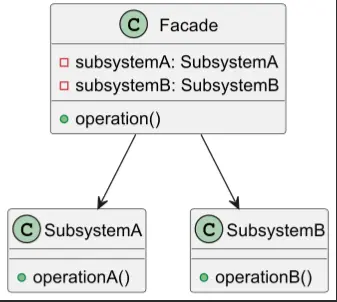外观模式
字数: 0 字 时长: 0 分钟
简介
外观模式(Facade Pattern)核心思想是:为复杂的子系统提供一个统一的对外接口。
UML 类图

- 外观类(Facade):对外提供统一接口,封装子系统的调用
- 子系统类(SubSystem):子系统类,提供子系统的功能
实现示例
利用外观模式屏蔽计算机启动过程系统内部的复杂性,只对外部暴露一个统一接口
java
// 1. 子系统组件 --- CPU
class CPU {
public void start() {
System.out.println("CPU 启动");
}
public void execute(String command) {
System.out.println("CPU执行指令: " + command);
}
}
// 2. 子系统组件 --- 内存
class Memory {
public void load(long pos, byte[] data) {
System.out.println("内存加载数据到位置:" + pos);
}
}
// 3. 子系统组件 --- 硬盘驱动
class HardDrive {
public byte[] read(long pos, int size) {
System.out.println("从硬盘读取扇区" + lba);
return new byte[size];
}
}
// 4. 外观类 (计算机启动器)
class ComputerFacade {
private final CPU cpu;
private final Memory memory;
private final HardDrive hardDrive;
public ComputerFacade() {
cpu = new CPU();
memory = new Memory();
hardDrive = new HardDrive();
}
// 计算机启动过程
public void start() {
// cpu 启动
cpu.start();
// 加载引导程序
byte[] bootData = hardDrive.read(0,1024);
memory.load(0,bootData);
// 执行引导程序
cpu.execute("BOOT");
}
}
// 5. 调用示例
public static void main(String[] args) {
ComputerFacade computer = new ComputerFacade();
// 客户端无需关心系统内部复杂流程
computer.start();
}